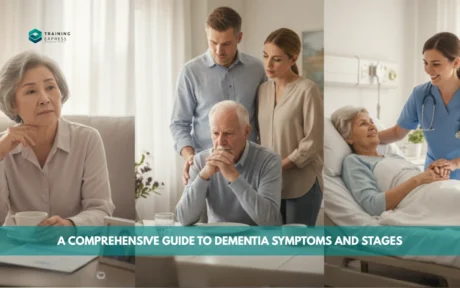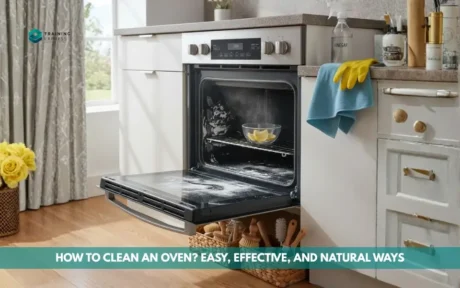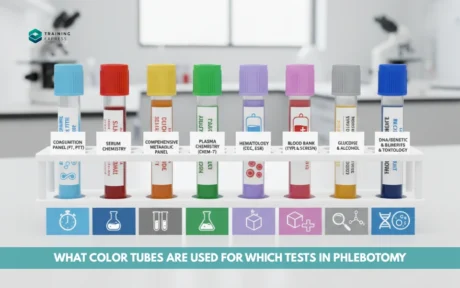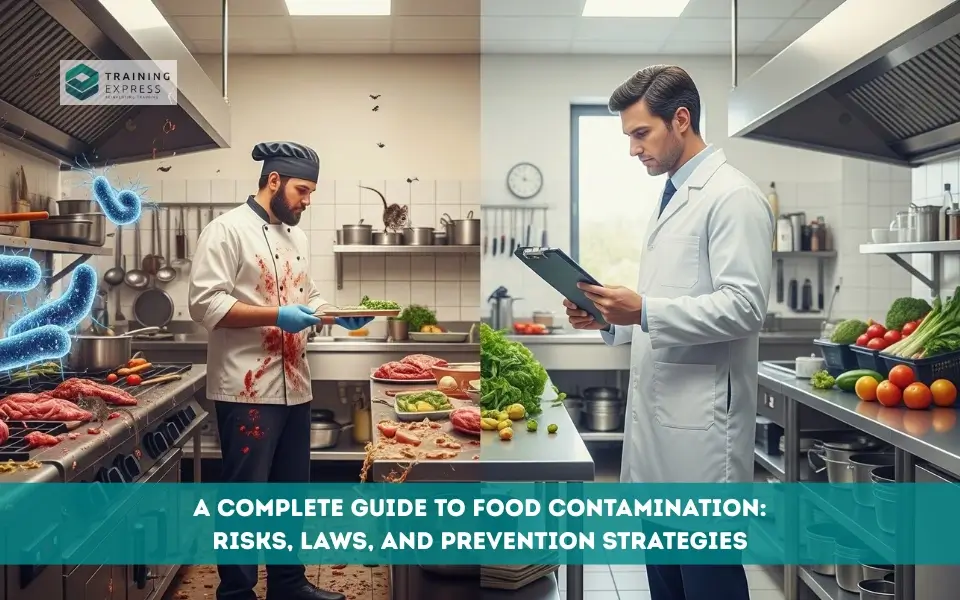
Food contamination poses a significant risk to public health and can have far-reaching consequences for consumers, producers, and the food industry as a whole. From unexpected physical objects in packaged meals to hidden allergens that can trigger life-threatening reactions, contamination can occur at any stage of the food production process.
Understanding the nature of these hazards is crucial for ensuring food safety, maintaining consumer trust, and complying with regulatory standards.
In this comprehensive guide, we explore the various types of food contamination, the physical, the chemical, and the allergenic, detailing their sources, risks, and the best practices for preventing them. You’ll gain insight into key frameworks like the ‘Six Ps’ of food safety, learn how to differentiate between food allergies and intolerances, and understand the legal responsibilities of businesses when it comes to human allergens.
Whether you work in the food industry or simply want to protect yourself and your family, this guide provides the essential knowledge you need to identify, manage, and minimise contamination risks.
In terms of how the law handles them, there are three main types of hazards that can contaminate food and cause harm to humans.
Table of Contents
These are classified as follows:
Physical items include pieces of glass, plaster and cement, screws, nails, pins, needles, and human hair.
Chemicals include things like petrol, cleaning solutions, antifreeze, and insecticides.
Allergenic foods and substances include nuts and seafood, which can produce an adverse bodily reaction in people.
It is legally required of you as a food handler to keep such risks from contaminating any food that you handle that is intended for human consumption during the whole preparation, storage, and serving process.
Physical Contamination
Anything that shouldn’t be in food will be considered a physical contamination.
In addition to the distress and disgust that come from merely discovering foreign items in food, these objects may potentially inflict pain or harm.
In addition to minor wounds like mouth cuts or broken teeth, their presence can be fatal if it results in internal bleeding or choking.
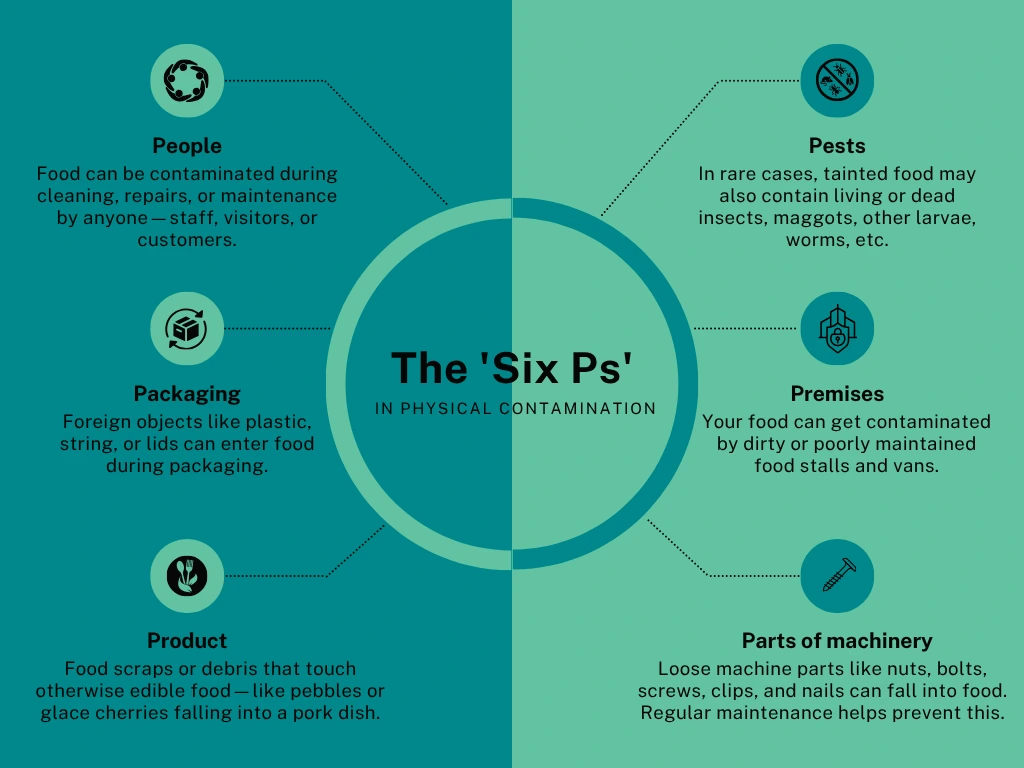
The 'Six Ps'
‘The Six Ps’ are a memorable way to describe the physical risks that might infiltrate the food:
People- When food is being cleaned, repaired, or maintained, anyone—including customers, visitors, and food handlers—can physically contaminate the food. Based on where they come from, physical pollutants can be divided into three main categories:
- Objects that may fall into food accidentally during food preparation
- Objects that are introduced carelessly to the food
- Objects that are introduced deliberately to the food
Packaging- When food is being packaged, some alien objects—such as plastic wrappers, crisp bags, string, polystyrene, lids, etc.—may be added.
Product- other food scraps or debris that comes into contact with food that would otherwise be completely edible. A nice illustration would be pebbles or glace cherries that fall into a pork dish.
Pests- In rare cases, tainted food may also contain living or dead insects, maggots, other larvae, worms, etc.
Premises- Your food can become contaminated by unsanitary food facilities, such as dilapidated buildings and poorly kept mobile food stands or vans.
Parts of machinery- Machine parts that can break free and fall into food include nuts, bolts, screws, clips and nails. In order to prevent pieces from getting into the food, machinery must also be properly maintained.
At all costs, keep everyone away from the food you are handling. The way that these items can be kept out of food will now be covered in greater detail.
Prevention and Controlling Physical Contamination
Physical contamination of food can be prevented and controlled in seven ways. They are:
- Providing all employees who handle food with the proper safety gear, such as masks, helmets, hairnets and dungarees or other garments with internal pockets
- Establish a strict protocol for reporting equipment flaws and ensure that employees understand how to document them appropriately.
- Always replace and fix worn-out, damaged, or broken pieces on food handlers’ equipment or in places where food is handled.
- Verify that all employees have received the necessary training to operate their tools and utensils in a safe and proper manner.
- Establish a procedure for glass breakage
- Put in place strict policies and procedures for pest management
- Ensure that all employees are aware of how to report pest indications and that they are required to do so.
What Are Chemical Hazards?

When potentially hazardous materials are added to food during handling, a chemical hazard results. Any point during the process of storing, preparing, or serving food could result in this circumstance.
- The following sources are frequently used to introduce chemical hazards:
- Cleaning supplies used or kept close to food
- The cleaning product residues left on surfaces or equipment used for food preparation
- Deliveries of food in vehicles that were formerly used to transport chemicals or hazardous waste
- Containers without labels that have not been thoroughly cleaned after containing dangerous materials
- Paint or corroding metal seeping into food from unsealed cans or containers kept in the refrigerator
- Waste disposal sites or industrial incinerators polluting the soil or air where food is grown
- The presence of lead or copper in the soil used to grow vegetables
- Fruit and vegetable mistreatment with fertilisers, pesticides, or herbicides, or the leftover residues on raw food
- Overuse or abuse of veterinary medications on household pets raised for food
How to Control Chemical Contamination?
Food contamination by chemicals must be avoided. The following are the most crucial methods for doing this:
- Seal, wrap, or pack food and its containers using food-grade packaging materials.
- Deliveries and storage of chemicals and food should always be kept apart.
- Chemicals and other materials should always be kept in containers that are tightly sealed and have clear labels.
- Store any potentially dangerous materials away from any food ingredients or products in a tightly sealed or closed space.
- Never keep food in outdated containers for chemicals or cleaning supplies.
- Always abide by the directions provided by the substance’s producer.
- For any products you use on your property, always be sure to work with reputable, trustworthy, and high-quality providers.
Allergenic Hazards
Our body is shielded from illness and infection by our immune system. When the immune system perceives a substance, like peanut compounds, as intrusive, it utilises proteins to seize the intruder and releases chemicals known as histamines, which cause the body to overreact.

The human body has an allergic reaction when the immune system attempts to combat a typically safe and nutritious food item because it perceives it as a threat.
An allergic reaction is typically instantaneous and can result in anything from mild physical symptoms like sneezing or skin reddening to more significant ones like life-threatening anaphylactic shock, which can be fatal if left untreated.
Major Types of Allergen
Employers and staff in the food industry need to be aware of the main allergens and make sure they are clearly marked on menus, product packaging, and ingredient lists.
These are the 14 most common ones:
- Celery and celeriac
- Cereals which contain gluten
- Crustaceans – prawns, shrimps, crabs, crayfish and lobsters
- Eggs
- Fish
- Lupin – the seeds of this flower are eaten as a snack in Mediterranean and Latin countries, and are now fashionable in the UK
- Molluscs – shellfish, squid (aka calamari) and octopus
- Milk and dairy products
- Mustard
- Nuts – including pistachios, brazil nuts, cashews, pecans, walnuts, macadamia nuts, hazelnuts and almonds
- Peanuts
- Sesame seeds
- Soya beans and extracts
- Sulphur dioxide and sulphites at levels above 10 mg per kg or 10 mg per L
Controlling Allergenic Contamination
There are four major stages in preventing and controlling allergenic contamination:
- Use trustworthy, approved vendors who adhere to an approved code of practice at all times.
- Verify that any product that may cause allergies is properly and clearly labelled and packaged.
- To avoid cross-contamination, make sure allergenic goods are stored apart from all other foods and ingredients.
- Maintain the cleanliness and segregation of all prep spaces, tools, clothing, and utensils used when preparing or storing allergic foods.
Food Allergy vs. Food Intolerance
Food intolerances and allergies are not the same thing, despite the fact that people frequently mix them together.
Although they may cause comparable physical symptoms, food intolerance is not an allergy but rather the result of hypersensitivity to particular foods.
However, after consuming these specific foods, food intolerance might still result in rashes, nausea, diarrhoea, and bloating, and these symptoms can last for a few days.
Individuals with food intolerances may occasionally eat tiny amounts of certain foods with little to no effect, but if they consume excessive amounts of the same item, they will experience severe consequences.
This isn’t the situation with food allergies, when a person with the illness may react visibly to even the smallest amount of an allergic meal.
Gluten, included in most wheat and other grain products, including beer, is arguably the most well-known food sensitivity.
Anaphylactic Shock

Anaphylactic shock, a condition in which a person’s blood pressure falls dangerously low, can be brought on by an allergic reaction.
An obvious swelling and reddening of the face and throat are the first signs of anaphylactic shock. Additionally, they will have trouble breathing and be extremely upset, frequently to the point of panic.
Anaphylactic shock and less severe allergic side effects can result from even minute quantities of an allergen. The effects on the majority of victims might manifest very quickly, and some people can pass away in a matter of minutes. For instance, a mere 1/44,000th of a peanut can be fatal to a person who is allergic to peanut proteins.
Treatment of Anaphylactic Shock
Take immediate action and adhere to this easy protocol if you are around someone who seems to be experiencing anaphylactic shock:
- Don’t move them.
- Make an ambulance call right away.
- If you know how to conduct CPR, do it if the person stops breathing, or find someone who can do it right away.
- After that, see how the person is doing.
The majority of people who are at risk for severe allergic responses will have an Epipen on hand, which is a tool that allows for quick injections of adrenaline to assist prevent the death of anaphylactic shock.
Human Allergens and the Law
Since December 2014, food businesses have been required by law to include information on any potential allergies in their goods on all packaging.
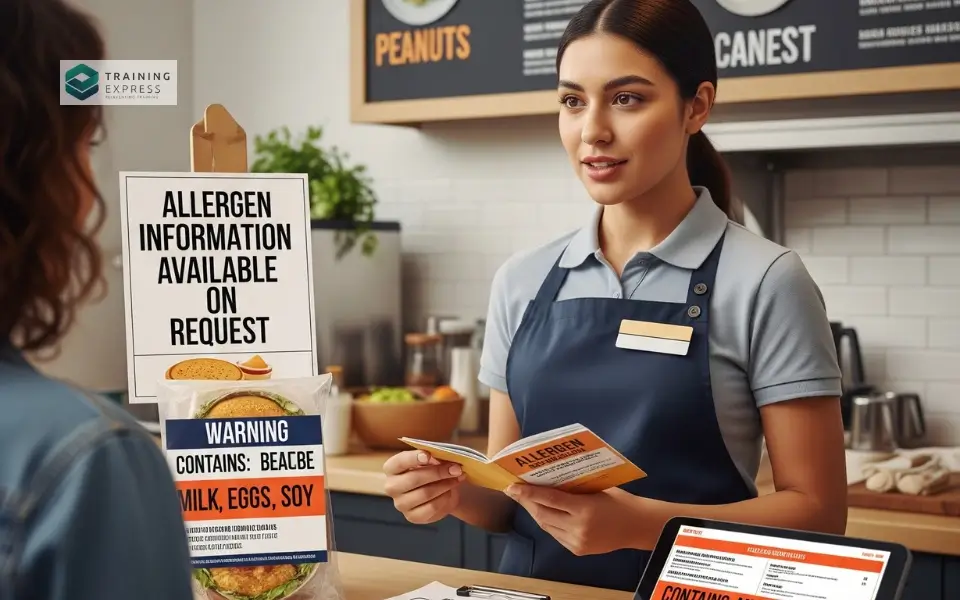
Otherwise, menus, labels, and signs for food that is being stored or presented without packaging must clearly state this information.
This is a crucial first step in preventing the ingestion of potentially fatal compounds in food by someone who may be at risk for anaphylactic shock.
Additionally, food companies are required to declare all allergenic food items by their most well recognised name. For instance, casein should be explicitly identified as a milk derivative, and albumen as an egg derivative.
To stand out to the consumer, the existence of such components needs to be highlighted in bold or differently coloured lettering.
If a customer requests it, all caterers are required to disclose any allergies in the cuisine; but, in order to do so, they must be aware of the precise allergens in their food.
Conclusion
Food contamination is a serious issue that demands constant vigilance, informed handling, and a deep understanding of potential hazards. By recognising the differences between physical, chemical, and allergenic contaminants—and knowing how to prevent them—individuals and businesses alike can uphold the highest standards of food safety. Effective prevention starts with proper training, stringent protocols, and a commitment to maintaining clean, controlled environments.
For food handlers, understanding the legal responsibilities and implementing robust safety measures is not just about compliance; it’s about safeguarding lives and protecting the integrity of the food supply chain. When these principles are consistently applied, the risk of contamination can be significantly reduced, ensuring a safer experience for everyone from farm to fork.
Frequently Asked Questions
What is the food contamination?
Food contamination is when something harmful or unwanted gets into your food, making it unsafe to eat. This “something” can be anything from tiny microbes you can’t see to physical objects or chemical residues.
There are generally four main types:
Biological contamination: The most common, involving harmful bacteria (like Salmonella, E. coli), viruses, or parasites.
Chemical contamination: When food comes into contact with cleaning products, pesticides, or even improper food-grade containers.
Physical contamination: Foreign objects like hair, glass, metal, or dirt accidentally entering food.
Allergenic contamination: When a food allergen (like peanuts or gluten) unintentionally mixes with food meant to be allergen-free.
Preventing contamination is crucial for food safety and public health, often involving strict hygiene, proper storage, and careful handling practices.
How to control food contamination?
Controlling food contamination boils down to four key principles: Clean, Separate, Cook, and Chill. Always start by washing your hands thoroughly with soap and water for at least 20 seconds, and ensure all surfaces and utensils are clean. To prevent cross-contamination, keep raw meats, poultry, and seafood separate from ready-to-eat foods, using different cutting boards and utensils. Cook foods to their safe internal temperatures, verified with a food thermometer. Finally, chill perishable foods promptly, refrigerating them within two hours to prevent bacterial growth. Following these steps consistently minimizes risks, whether you’re cooking at home or managing a professional kitchen.
What is a definition of contamination?
Contamination refers to the presence of an unwanted substance where it shouldn’t be, rendering something impure or unsafe. This can apply to a wide range of situations, from harmful microbes in food or water making it unfit for consumption, to pollutants in the environment impacting air quality, or even an unwanted chemical spoiling a carefully crafted laboratory experiment. Essentially, it’s about an undesirable element compromising the integrity or usability of something else.
What causes contamination?
Contamination occurs when unwanted substances, whether biological, chemical, or physical, enter an environment, making it impure or unsafe. Common culprits include improper waste disposal, leading to pollutants leaching into soil and water, and industrial activities releasing harmful chemicals or byproducts.
Biological contamination often stems from microorganisms like bacteria and viruses spreading through poor hygiene or cross-contamination. Physical contamination can involve foreign objects like glass or metal entering products. Natural events such as volcanic eruptions or floods can also cause contamination by dispersing toxic materials. Understanding these diverse sources is crucial for prevention and maintaining a healthy environment.
What are common sources of food contamination?
Common sources include:
Dirty hands or utensils
Cross-contamination between raw and cooked foods
Improper food storage (wrong temperatures)
Contaminated water or ingredients
Pests, such as rodents or insects
These sources can introduce harmful microbes or substances into food.
What are the health risks of eating contaminated food?
Eating contaminated food can lead to food poisoning. Symptoms include nausea, vomiting, diarrhoea, stomach cramps, and fever. In severe cases, especially for young children, older adults, or those with weakened immunity, it can result in long-term illness or death.
Related Blogs
- Available Courses
- Animal care10
- Design28
- Training9
- Accounting & Finance Primary49
- Teaching & Academics Primary37
- Teaching23
- Quality Licence Scheme Endorsed171
- Law10
- IT & Software229
- Job Ready Programme52
- Charity & Non-Profit Courses28
- HR & Leadership4
- Administration & Office Skills4
- Mandatory Training36
- Regulated Courses4
- AI & Data Literacy24
- Health and Social Care290
- Personal Development1622
- Food Hygiene117
- Safeguarding80
- Employability287
- First Aid73
- Business Skills293
- Management425
- Child Psychology40
- Health and Safety531
- Hospitality28
- Electronics31
- Construction62
- Career Bundles201
- Marketing39
- Healthcare172

 Food Hygiene
Food Hygiene Health & Safety
Health & Safety Safeguarding
Safeguarding First Aid
First Aid Business Skills
Business Skills Personal Development
Personal Development
